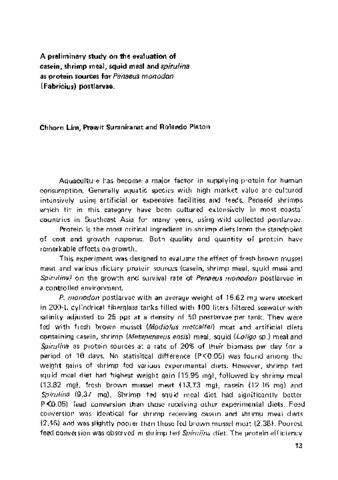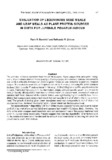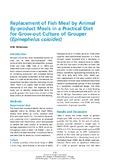Fish performance, nutrient digestibilities, and hepatic and intestinal morphologies in grouper Epinephelus fuscoguttatus fed fermented copra meal
- Global styles
- MLA
- Vancouver
- Elsevier - Harvard
- APA
- Help

Download URL
www.sciencedirect.com日付
2019-07Page views
1,734ASFA keyword
AGROVOC keyword
Taxonomic term
Metadata
アイテムの詳細レコードを表示するCited times in Scopus
Share
抄録
Protein enhanced copra meal (PECM®) is an alternative, cheap, and sustainable source of plant protein for the aquafeed industry, albeit its use on carnivorous fish species has been very limited. A 70-day feeding trial using grouper Epinephelus fuscoguttatus (initial mean body weight of 1.86 ± 0.19 g) tested fermented copra meal as feed ingredient. Six isonitrogenous (crude protein of 45%) and iso-lipidic (crude fat of 11%) diets consisted of PECM®: a control diet at 0% soybean meal replacement (C); four diets replacing soybean meal at 25% (FC25), 50% (FC50), 75% (FC75), 100% (FC100) – all with methionine and lysine supplementation; and 100% soybean replacement without methionine and lysine supplementation (FCW100). Growth and feed performance were not significantly (P > 0.05) affected by PECM® replacement of soybean meal up to 100%, even without methionine and lysine supplementation. Chemical body composition was likewise not significantly (P > 0.05) altered. PECM® when used as a grouper feed ingredient has protein, lipid, carbohydrate and dry matter digestibilities of 89.28%, 78.63%, 82.57%, and 48%, respectively. Hepatic and intestinal morphologies displayed no apparent pathological changes. PECM® can be efficiently utilized by grouper and can replace soybean meal up to 100% (16% in diet) for normal fish performance and digestive organ functions.
Suggested Citation
Mamauag, R. E., Ragaza, J. A., & Nacionales, T. (2019). Fish performance, nutrient digestibilities, and hepatic and intestinal morphologies in grouper Epinephelus fuscoguttatus fed fermented copra meal. Aquaculture Reports , 14, 100202. https://doi.org/10.1016/j.aqrep.2019.100202
Type
ArticleISSN
2352-5134Collections
- Journal Articles [1247]
Except where otherwise noted, this item's license is described as https://creativecommons.org/licenses/by/4.0/
Related items
Showing items related by title, author, creator and subject.
-
A preliminary study on the evaluation of casein, shrimp meal, squid meal and spirulina as protein sources for Penaeus monodon (Fabricius) postlarvae
Lim, Chhorn; Suraniranat, Prawit; Platon, Rolando (Aquaculture Department, Southeast Asian Fisheries Development Center, 1978)P. monodon postlarvae were fed with fresh brown mussel (Modiolus metcalfei) meat, and artificial diets containing casein, shrimp (Metapenaeus ensis) meal, squid (Loligo) meal, and Spirulina as protein sources at a rate of ... -
Evaluation of leguminous seed meals and leaf meals as plant protein sources in diets for juvenile Penaeus indicus
Eusebio, Perla S.; Coloso, Relicardo M. (Society of Israeli Aquaculture and Marine Biotechnology, 1998)The potential of locally available legumes (white cowpea, Vigna unguiculata, and green mung-bean, Vigna radiata) and leaf meals (papaya, Carica papaya, and cassava, Manihut esculenta) in combination with defatted soybean ... -
Series: ACIAR Monograph 110
Replacement of fish meal by animal by-product meals in a practical diet for growout culture of grouper (Epinephelus coioides)
Millamena, Oseni M. (Australian Centre for International Agricultural Research, 2004)This study was conducted to develop compounded feeds having a low content of fish meal for juvenile grouper and as an alternative to trash fish feeding. Epinephelus coioides juveniles were stocked in 36 units of 250-litre ...







